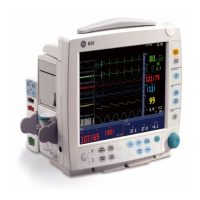B30 Patient Monitor
12-6
During monitoring
WARNING Check the sensor site every four hours (more frequently if the perfusion is
poor). Routinely check to ensure adequate circulation distal to the sensor
site.
Patient condition or prolonged use may require changing the sensor site periodically. Check
skin integrity, circulatory status and correct alignment and change sensor site at least every
four hours.
For patients with poor peripheral blood circulation or sensitive skin, change the site at intervals
of 30 minutes to one hour. To confirm the circulatory status, observe the size of the
plethysmographic waveform with a fixed pleth scale. Take special care of this when monitoring
small children.
If possible, do not attach the SpO2 sensor on a limb that is used for NMT measurement or for
administrating cold infusions.
NIBP measurement and arterial blood pressure measurement
To avoid erroneous readings, do not use a blood pressure cuff or arterial blood pressure
measurement device on the same limb as the sensor.
Plethysmographic pulse wave
To get an optimal pulse wave use smaller scale indicators when using measuring sites with
poor perfusion. A small pulse wave may be a sign of impaired circulation that may require
increased attention.
Higher scale indicators together with a well defined pulse wave indicate strong circulation and
a relaxed patient.
Removing the sensor
•
Open the sensor. Do not pull the sensor from its cable.

